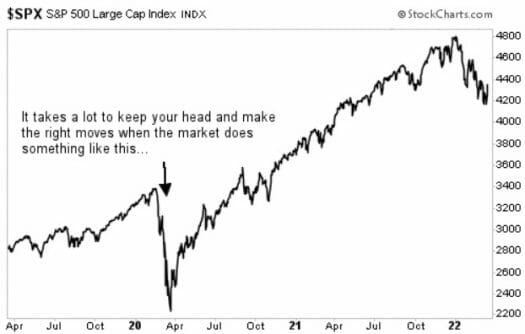The Banking Fiasco… When Emotions Rule The Market… 6 Tips To Survive Market Turmoil
 We witnessed a case study in how human behavior and emotions drive markets this week. Let’s start with a story…
We witnessed a case study in how human behavior and emotions drive markets this week. Let’s start with a story…
Early Monday morning (March 13) I got a frantic text from my mother-in-law. She very rarely texts me.
It read: “We are hearing a lot of noise about banks… will you call us.”
They were ready to march to their local banks, pitchforks in hand, and demand their money. Everybody was. This uneasiness was a ripple effect from the collapse of Silicon Valley Bank (SVB) — the 16th largest bank in the United States — on Friday, March 10.
It is the second largest bank failure on record, behind Washington Mutual Trust in 2008.
Signature Bank (Nasdaq: SBNY) also collapsed. Over the weekend, the government stepped in and assured the public- and depositors at SVB and SBNY- that their deposits were safe and would be made whole, even those above the $250,000 FDIC insurance limit.
But the reassurance fell on deaf ears.
As Monday morning came, regular folks were panicking. The bank run was on, and investors were dumping regional bank stocks.
Like First Republic Bank (NYSE: FRC), which caters to Silicon Valley elites and other high-net-worth clients. Shares fell over 65% Monday morning…

PacWest Bancorp (NYSE: PACW) fell over 60%… Comerica (NYSE: CMA) lost over 35%… the Invesco KBW Regional Banking ETF (Nasdaq: KBWR) shed over 15%.
Even the big boys took a haircut. Charles Schwab (NYSE: SCHW) lost over 30%. JPMorgan Chase (NYSE: JPM) has seen shares slide over 10%, and Wells Fargo (NYSE: WFC) is down nearly 20%.
When Emotions Rule The Market
And here’s the thing… this all could have been avoided. Sure, a bank here or there might have failed because, believe it or not, banks fail nearly every year. Eight banks failed between 2019 and 2020. And eight banks went under in 2017 alone.
But when someone says, “don’t panic.” Everyone panics. And that’s exactly what the CEO of Silicon Valley Bank said on a call. Had there not been a run on SVB, it would likely still be around today, and the wild swings in banking stocks (and the market at large) would have been avoided.
But alas, emotions and human behavior (especially when it comes to money) ruled the day. And believe it or not, this is often the case. In fact, over at Maximum Profit , our system essentially make trades based on other people’s irrationality and how it affects the markets. We just saw that play out in spectacular fashion.
If you’re thinking about dipping your toes into the banking sector because of the massive selloffs, be careful. The same emotion/momentum we take advantage of to the upside works the same for the downside. Many of these stocks can fall much lower from here.
Good Investing,
Jimmy Butts
StreetAuthority Insider
Editor’s Note: For the remainder of today’s issue, we’re handing things back over to Brad Briggs, who shares some essential keys to surviving turmoil in the markets…
Worried About Market Turmoil? Follow These 6 Tips To Survive And Come Out Ahead…
September 15, 2008, was a date that marked an important change in the way investors looked at the markets.
If your memory is a little fuzzy, that’s the day that the investment bank Lehman Brothers filed for bankruptcy.
Most of us in the market the day know what happened next. Waves of foreclosures… More bankruptcies… Global trade halted… Credit markets went bone-dry.
In fact, we came extremely close to a “systemic meltdown,” according to the International Monetary Fund. From the peak on October 9, 2007, to the bottom on March 9, 2009, the S&P 500 dropped 56.8%.
I’m not here to bring these events up to force you to relive those days. Instead, I am here to remind you of a simple fact: We survived.
Fast-forward to March 2020. Less than 12 years after the financial crisis, we were subjected to another economic trauma as Covid-19 spread around the globe and brought life to a standstill. States issued “shelter in place” orders, stores closed, and people stayed at home. Zoom meetings became a thing. Food, guns, and ammo flew off the shelves (along with toilet paper). And once again, markets tanked.

What’s important to keep in mind is that this is in the rearview mirror. Still, I wouldn’t blame you one bit if you didn’t get a bad feeling in the pit of your stomach when this latest bout of volatility hit and the markets started trending lower.
After two (albeit very different) major economic crises in our lifetimes, investors are understandably justified to feel a little traumatized. In fact, one of the most frequently asked questions we get is what to do when the next big market crash comes.
It’s time to put some of those concerns to bed. Below is a list of tips I’ve edited and compiled from our premium experts over the years that I always keep handy. They address how to stay objective with your portfolio regardless of what’s going on…
6 Tips To Keep Your Head
1. Remember that the experts can be wrong. In fact, the experts can be wrong for a long, long time. And business television channels find guests with extreme views just to drum up ratings. So please don’t lose a minute of sleep over the ramblings of pundits or television talking heads.
Try to take a coldly rational approach to what the “experts” say. Ask yourself where their bread is buttered, so to speak. Think for yourself.
2. Maintain a comfortable cash cushion. As investors, we have been made to feel guilty about holding cash. It’s as if we’re shirking our responsibilities. We feel like we should always have our entire portfolio working for us. But cash does work for us. Cash holds up pretty darn well in a downturn. Cash helps us sleep better at night, no matter what the market throws at us. And cash allows us to buy opportunities during a downturn without liquidating another position.
How much cash you hold is a personal decision based on your financial needs, market conditions, and your risk tolerance. But if you wake up during the night worried about your investments, you probably need a little more cash in your portfolio.
3. Count your gains or dividends. Positive reinforcement is a valuable tool, especially if the pundits (or markets) turn negative. I like to review the gains I’m sitting on from my longest-tenured holdings to see how far I’ve come. The point isn’t to deny reality but rather to gain perspective. When you’re sitting on a long-term winner of, say, 250%, then a 10% correction is a lot easier to digest.
4. Reevaluate your holdings. The goal for most investors is to buy, hold, and reinvest for the long haul. It rarely pans out that way.
But when global economic or political conditions change, it is always a good idea to assess its potential impact on your holdings. To do this, you must stay objective, which can be difficult when information is limited, and panic starts to rear its ugly head. Sell only what you believe has a significant negative outlook — and leave the rest alone.
5. Be careful with your stops. Stop-losses can be tricky. I don’t want to tell you not to use them, but think twice before you put one in place. The last thing you want is to get stopped out of a position at a low price only to watch it rebound at the end of the day or week.
If it’s a stock with a history of wild price swings, think about how you might react. Will you be glad you got out? Or will you be mad because you may actually want to buy more? Do this before putting the stop in place. If you want out of a position or need to raise cash — go ahead and sell. It takes discipline, but you need to develop this skill to succeed in the long run.
6. Keep a shopping list. During the recent bull markets, there has been an acronym that investors and traders like to throw around when the enthusiasm is still high: BTFD. (Buy The Dip – I’ll let you guess what the F means.) This is not an endorsement to buy the dip every time. After all, what looks “cheap” today could be cheaper tomorrow.
I keep a watchlist of securities I wish I had bought the last time the market tanked. Occasionally, I may buy if it’s still a good deal today. But if the Dow ever pukes up 2,000 points, you can bet I’ll be ready to go shopping with a high degree of conviction whenever I pull the trigger.
As an added bonus, income investors have a special incentive for bargain shopping high-quality income securities on dips because yields rise when prices fall. And it’s one reason why it always helps to keep a little extra cash on hand.
Closing Thoughts
I don’t know when the recent choppiness in the market will let up. I don’t have a crystal ball. But I know that if you keep these tips in mind, you’ll be much better prepared for whatever the market throws at us next.
Another major event is always around the corner. In an ideal scenario, when that happens, you’ll have these tips printed off next to you (or stored away safely in your head). And as you watch the talking heads on television start to wave their arms in exasperation as the next major economic event unfolds and everybody else around you panics, you’ll smile quietly to yourself because you’re ready.
In the meantime, if you’re looking for game-changing ideas with serious upside, then you should check out our investment predictions for 2023 (and beyond)…
This report is full of research that challenges the conventional wisdom. And while we don’t have a crystal ball, many of our past predictions have come true, allowing investors the chance to rake in gains of 622%, 823%, and even 1,168%.
From the U.S. dollar to driverless trucks to breakthrough cancer treatments and more… If you’re looking for some “home-run” ideas for your portfolio, then I can’t think of a better place to start.
